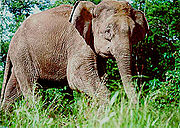
Pygmy Elephant
Encyclopedia

Africa
Africa is the world's second largest and second most populous continent, after Asia. At about 30.2 million km² including adjacent islands, it covers 6% of the Earth's total surface area and 20.4% of the total land area...
and Asia
Asia
Asia is the world's largest and most populous continent, located primarily in the eastern and northern hemispheres. It covers 8.7% of the Earth's total surface area and with approximately 3.879 billion people, it hosts 60% of the world's current human population...
. The African pygmy elephant, formerly described as "Loxodonta pumilio", is currently considered to be a tiny morph of the African Forest Elephant
African Forest Elephant
The African Forest Elephant is a forest dwelling elephant of the Congo Basin. Formerly considered either a synonym or a subspecies of the African Savanna Elephant , a 2010 study established that the two are distinct species...
(L. cyclotis); see Debruyne et al. (2003).
The Borneo Elephant
Borneo Elephant
The Borneo Elephant also called the Borneo Pygmy Elephant inhabits northeastern Borneo. Its origin remains the subject of debate. A definitive subspecific classification as Elephas maximus borneensis awaits a detailed range-wide morphometric and genetic study...
(Elephas maximus borneensis), a well-documented variety of elephant, is also called "pygmy elephant." This elephant, inhabiting tropical rainforest
Tropical rainforest
A tropical rainforest is an ecosystem type that occurs roughly within the latitudes 28 degrees north or south of the equator . This ecosystem experiences high average temperatures and a significant amount of rainfall...
in north Borneo
Borneo
Borneo is the third largest island in the world and is located north of Java Island, Indonesia, at the geographic centre of Maritime Southeast Asia....
(east Sabah
Sabah
Sabah is one of 13 member states of Malaysia. It is located on the northern portion of the island of Borneo. It is the second largest state in the country after Sarawak, which it borders on its southwest. It also shares a border with the province of East Kalimantan of Indonesia in the south...
and extreme north Kalimantan
Kalimantan
In English, the term Kalimantan refers to the Indonesian portion of the island of Borneo, while in Indonesian, the term "Kalimantan" refers to the whole island of Borneo....
), was long thought to be identical to the Asian Elephant
Asian Elephant
The Asian or Asiatic elephant is the only living species of the genus Elephas and distributed in Southeast Asia from India in the west to Borneo in the east. Three subspecies are recognized — Elephas maximus maximus from Sri Lanka, the Indian elephant or E. m. indicus from mainland Asia, and E. m....
and descended from a captive population. In 2003, DNA
DNA
Deoxyribonucleic acid is a nucleic acid that contains the genetic instructions used in the development and functioning of all known living organisms . The DNA segments that carry this genetic information are called genes, but other DNA sequences have structural purposes, or are involved in...
comparison revealed them to be probably a new subspecies.. A 2010 study found that there are an estimated 2,040 elephants in Sabah..
The term pygmy elephant should not be confused with "dwarf elephant
Dwarf elephant
Dwarf elephants are prehistoric members of the order Proboscidea, that, through the process of allopatric speciation, evolved to a fraction of the size of their immediate ancestors...
", which is used for a number of extinct
Extinction
In biology and ecology, extinction is the end of an organism or of a group of organisms , normally a species. The moment of extinction is generally considered to be the death of the last individual of the species, although the capacity to breed and recover may have been lost before this point...
species of elephants that evolved
Evolution
Evolution is any change across successive generations in the heritable characteristics of biological populations. Evolutionary processes give rise to diversity at every level of biological organisation, including species, individual organisms and molecules such as DNA and proteins.Life on Earth...
their size due to island dwarfing
Insular dwarfism
Insular dwarfism, a form of phyletic dwarfism, is the process and condition of the reduction in size of large animals – typically mammals – when their population's range is limited to a small environment, primarily islands. This natural process is distinct from the intentional creation of dwarf...
.
Pygmy elephants of India
Though claims have been made from the Western GhatsWestern Ghats
The Western Ghats, Western Ghauts or the Sahyādri is a mountain range along the western side of India. It runs north to south along the western edge of the Deccan Plateau, and separates the plateau from a narrow coastal plain along the Arabian Sea. The Western Ghats block rainfall to the Deccan...
of (Kerala
Kerala
or Keralam is an Indian state located on the Malabar coast of south-west India. It was created on 1 November 1956 by the States Reorganisation Act by combining various Malayalam speaking regions....
, India
India
India , officially the Republic of India , is a country in South Asia. It is the seventh-largest country by geographical area, the second-most populous country with over 1.2 billion people, and the most populous democracy in the world...
) concerning a dwarf species of elephant called "Kallana
Kallana
Kallana is the Malayalam language name of a suspected species of dwarf elephants allegedly found in South India. Kaani tribals dwelling in the rainforests of the Western Ghats claim that there are two distinct varieties of elephants in the Peppara forest range, one the common Indian elephants ,...
," a team of elephant experts found no evidence of their existence in the area.

